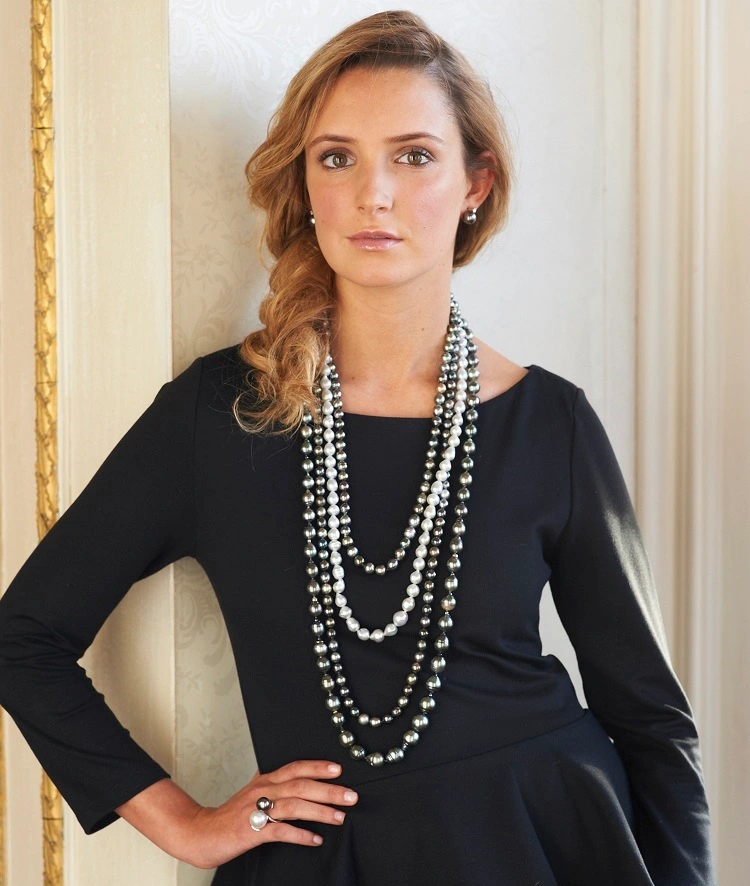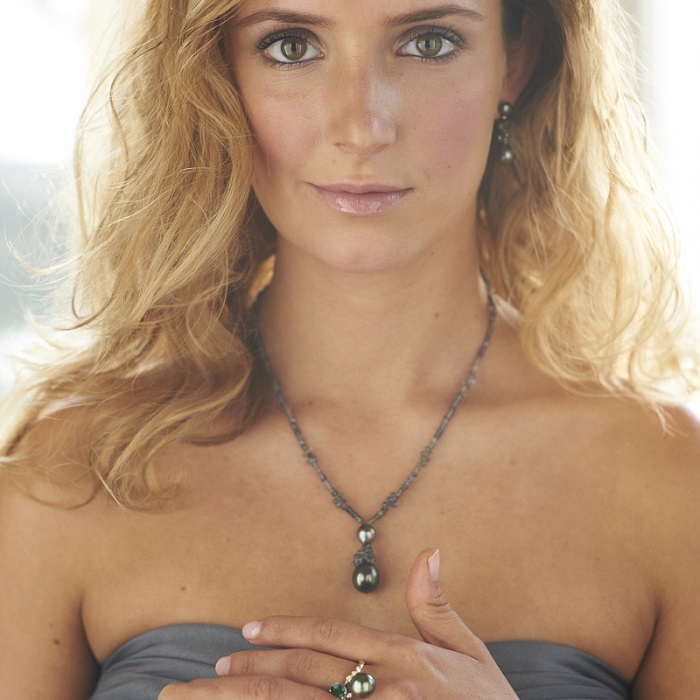Tahitian Black Pearls

Learn the Ins and Outs of Tahitian Pearls
“Pearls are the most natural gemstone that you can wear. With proper care they will give you a lifetime of pleasure.”
Chrissie Douglas
Tahitian pearls are produced in black lipped oysters in the warm ocean waters of French Polynesia, East Australia, Mexico and Panama.
Their colour range goes through the entire gamut from black to white through aubergine, baby pink, pistachio brown and even copper. All these colours will have the signature grey overtone which is produced by the epithelial cells of the Pinctada Margaritifera – the Black Lipped Oyster.
Read on to discover everything you need to know about these fascinating, inky pearls…
How are Tahitian pearls produced?
The epithelial cells of the Pinctada Margaritifera oyster have a very important role, which is to protect the oyster from predators. They coat the entire shell with nacre starting at the hinge. The nacre then hardens and makes the oyster less tempting as a snack for other sea creatures.
Epithelial cells lay thousands of microscopic layers of nacre upon the inner protective coat of the oyster shell – a substance we call Mother of Pearl. Epithelial cells are also the emergency services for the oyster as they cover any intruder that could potentially kill the oyster with nacre. This is how natural pearls are formed.
Cultured Tahitian pearls are started by humans (though never man made). A host oyster is seeded with a nucleus alongside a section of epithelial cell tissue. The majority of Tahitian pearls seen in jewellery shops and top end fashion magazines are cultured Tahitian pearls. Fortunately, pearls improve their lustre when worn next to the skin, as the oils of the person wearing them keep the pearls moisturised. So, in actual fact, wearing your favourite jewellery is the number one priority to keep it looking its best.

A brief history of Tahitian pearls
When cultured pearls appeared on the market they were considered ‘fake’ real pearls, as they were easily found within the confines of a pearl farm within calm sea lagoon waters or protected bays.
However, we need to bear in mind that when cultured pearls appeared on the world stage, a triple natural pearl strand necklace was swapped by an American heiress for her Manhattan home – what is now the Cartier headquarters on Maddison Avenue. Pearls at the time were the ultimate sign of power and wealth.
Style inspiration
Black Tahitian pearls can be elegant or casual, red carpet or beach appropriate. Take a look at the various ways to style them below.




How rare are Tahitian Pearls?
Natural black pearls are very rare. For perspective, we will find only 3 per 5,000 oysters. With cultured pearl farming, around 200 in every 1000 oysters seeded will create pearls of sufficient quality to sell.
Of those, around 50 pearls will be the standard required for jewellery.
Following the ‘seeding’ of an oyster, it will be intensively nursed for 3 years in order to keep it clean, healthy and free of disease.
It takes the entire life of an oyster living in the balmy waters of a farm to create a single cultured pearl or very occasionally two – if the oyster is considered strong enough to produce two pearls.
From the entire seeded harvest, 50% of the oysters will have failed to produce any pearl at all, either by dying in the attempt or by spitting out the irritant. Out of the 50% left, well over half the pearls produced are too blemished or unformed to be sold, so they are discarded and binned. This leaves 20% of the entire harvest which is of sufficient quality to sell and only 5% of these are the top quality. So in short, beautiful Tahitian pearls are rare and should indeed be prized.
How can you tell if a black pearl is real?
We should start by explaining that cultured or natural pearls are made up of nacre. Nacre is made up of tiny calcium carbonate platelets held together with a protein called conchiolin. The same materials our teeth are made from, however our tooth’s protein is harder than the pearls, hence why some people suggest you try the old fashioned method of checking if a pearl is real by passing it past your teeth.
The idea is that your teeth feel the rough texture of a pearl and while it is possible to do, it’s also very unhygienic – you never know whose teeth have been there before yours! Worse still, your teeth will scratch the surface of your pearl.
The best way to test if a pearl has nacre is by rubbing one pearl against another. As imitation pearls are made by dipping beads in fish slime or coating beads in acrylic paint, these methods mean a liquid has been applied onto a bead. As such, there will be no gritty feel.
Are Tahitian pearls worth buying?
As pearl experts with over three decades in the industry,our resounding answer is yes. But don’t just take our word for it.
Pearls are the best investment anyone can make in looking and feeling confidently beautiful. Because natural and cultured pearls enhance the beauty of their wearer, they are in fact the best and least painful face lift anyone could have!
The glow that comes from a pearl is read as one alongside the glow of the wearers skin. The eye of the beholder reads both pearls and skin as one reading because of the way light reflects and refracts both off our skin and the pearls surface in exactly the same way. Hence, someone wearing pearls fools the eye of the onlooker into personally acquiring the glow of their pearls as their own. Pearls will enhance the beauty of their owner for life if treated well, that to us is a truly worthwhile investment.
How much does a Tahitian pearl cost?
There are several factors involved in assessing the value of a pearl. These include its size, colour, overtones, lustre, shape, the smoothness of its skin and the perfection in matching.

Size
This is the easiest factor to address. The bigger the Tahitian pearl (all other parameters equal), would make the pearl more expensive. Because the Pinctada Margaritifera grows up to 6 inches wide, their size can therefore vary from 8 to a maximum of 18mm, which is huge in relation to the size of the oysters organs as pearls are cultured near the hinge of the mollusc.

Colour and overtones
The most common colour for a Tahitian pearl is aubergine with both deep green and burgundy overtones. Meanwhile, the rarest shades are pastel colour Tahitian pearls. Other colours include pastel pink Tahitian pearls with pink overtones, pale blue Tahitian pearls with blue overtones and pistachio colours. Bright copper hues are also incredibly rare.

Lustre
In our opinion, lustre is the most important factor regarding value, as it is the lustre of a pearl that will enhance the wearer’s radiance. A dull pearl, however large, will always look dull and uninspiring, a dull pearl will look like a dead fish eye. Lustre is what attracts the eye of the beholder, due to its play of colour and light.

Shape
The shape of a pearl defines its value in as much as the perfect round pearl is the most prized, alongside the perfect drop shape. Recently market forces have meant that baroque pearls are very expensive as they are in short supply. Our suggestion is to find the pearl that best suits the wearer. A regular featured face will suit rounder pearls, while a face with unusual, defining characteristics will be best suited to drop shapes or baroque.

Clarity of skin
The pearl grows inside a living organism. As such, pearls are the most natural gem known to man, the farmer will have no control over what pearls are produced. The skin surface often has tiny marks, which in our opinion give a pearl the hallmark of genuineness.
The exception to this is when the blemish is dull, as this means that the nacre coating has not formed properly in that area. Ringed pearls which are formed when an obstruction marks the pearls surface during the natural formation of nacre round the irritant, as pearls rotate as they grow within their pearl sac, the rings are formed rather like a mark formed on a potters lathe. Circular indentations on the pearls surface bring their value down.

Perfection in matching
This is only important if it is a pair or a row of pearls in the same colour and overtone. Even in a multicolour Tahitian pearl row, it is important that the overtones match otherwise the necklace will look disjointed and as though no thought was put into it.
Interesting facts about Tahitian pearls
The Princess of Piedmont, Queen of Italy, Margherita of Savoy, eclipsed her husband’s popularity. He was unfaithful throughout their marriage yet they worked as a team. Her fondness for jewellery, especially pearls, which she donned when posing for portraits, earned her the nickname “Queen of Pearls.” As a couple they were great friends and as her husband wanted to please her throughout his infidelity, he knew exactly what to buy her for every occasion… pearls – and black Tahitian pearls as a preference.
Speaking of gifts, have you seen the Woody Allen film ‘Small Time Crooks’ where Frenchie is offered a Tahitian pearl necklace and she comments: “gee were they bad oysters?” She should have read this website!
On the lookout for your own set of Tahitian pearls?
Visit Coleman Douglas Pearls to browse their full range of Tahitian pearl jewellery and to learn more about their incredible thirty year history in the industry.